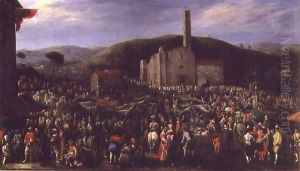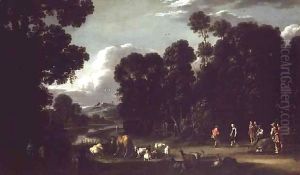Filippo de Liano d' (Napoletano) Angeli Paintings
Filippo d'Angeli, also known as Filippo Napoletano or Filippo de Liano, was an Italian painter of the Baroque period. Born in 1589 in Naples, which was at the time part of the Spanish Empire, he was known for his genre scenes, landscapes, and battle scenes that reflected a blend of the vibrant Neapolitan tradition and the influence of northern European art, which he encountered during his travels.
Napoletano's life was marked by extensive travels throughout Italy and beyond. Early in his career, he moved to Rome, where he was influenced by the works of Caravaggio and his followers. Caravaggio's dramatic use of chiaroscuro and his focus on realism left a lasting impression on Napoletano's style. While in Rome, he became associated with the Bamboccianti, a group of genre painters who depicted everyday life, often with a comical or picturesque element.
Around 1616, Filippo Napoletano traveled to Florence, where he entered the service of Cosimo II de' Medici, the Grand Duke of Tuscany. During this period, he produced several works for the Medici court, including landscapes and scenes of local festivities, which were well-received due to their liveliness and attention to detail.
Napoletano's work was characterized by an eclectic approach; he often incorporated elements from various sources into his paintings. His landscapes, for example, showed the influence of Paul Bril and northern European artists, while his battle scenes were reminiscent of the works of Jacques Callot. Despite his success, his life was somewhat tumultuous, and historical records suggest that he had a fiery temperament, which sometimes led to trouble with patrons and authorities.
The painter's last years were marked by a return to Naples, where he continued to work until his premature death in 1625. Although he died relatively young, Napoletano's oeuvre had a considerable impact on the development of genre painting in Italy. His legacy was carried on by his followers and by artists who were inspired by his ability to fuse the naturalistic detail of northern European art with the dynamism and color of the Italian tradition.

